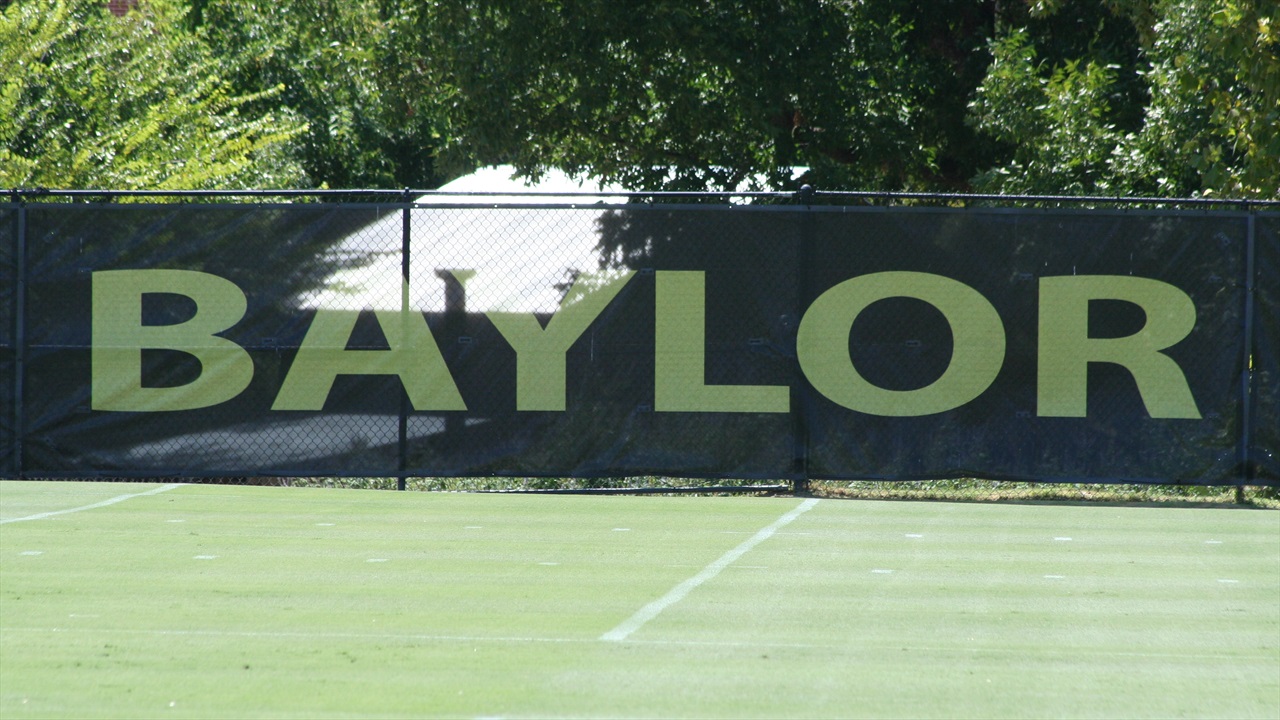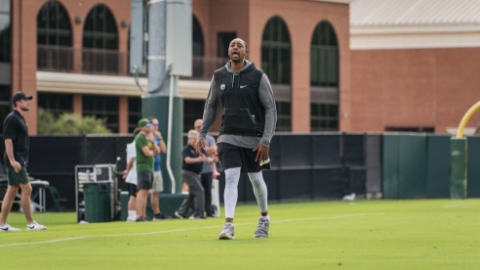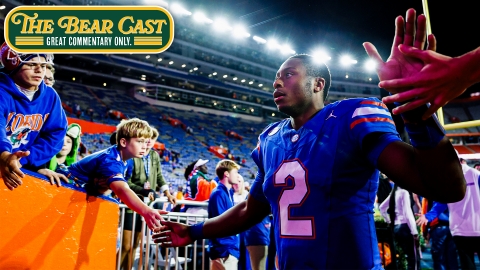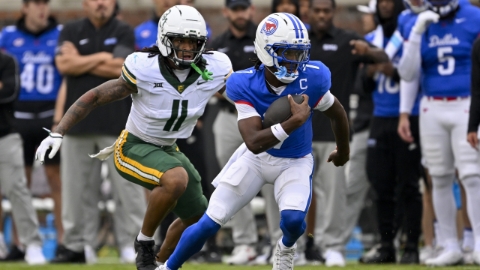good write-up S11. Five SEC transfers (A&M, Alabama (2), Arkansas, South Carolina) on KU's roster. They are upgrading talent.

After surviving their trip to Ames, the Baylor Bears return to Waco for a homecoming date with the Kansas Jayhawks who just took TCU to the wire in Lawrence. The Jayhawks come in with a 1-4 record but were competitive with Texas Tech through three quarters and were missed field goals away from beating TCU over the last two weeks.
The head coach of Kansas is David Beatty. Beatty is former Texas High School coach with extensive assistant coach experience at Kansas, Texas A&M, and Rice on the offensive side of the ball. Beatty was involved in some of the strongest offenses in each school's recent memory. He's a tireless recruiter as well. He was present for Kansas's run of success under Mangino in the late 2000's and understands the campus and what it takes to recruit to Lawrence. KU has not had a lot of success his first one and a half seasons but most of that can be traced back to the very depleted roster he walked into with fewer than 60 scholarship players in his first season.
Offensive Coordinator Rob Likens along with Head Coach Beatty have installed a variation of the Air Raid system. This is a grandchild of the scheme that Mike Leach and Texas Tech used to shake up the Big 12.
In the passing game they will use a lot of the passing game staples that Baylor saw from Northwestern State and Oklahoma State. The goal is to spread a defense out with the pass and get the ball to playmakers in space. They are passing so that the run then opens up with favorable fronts and angles which takes the pressure off their line. When the Jayhawks run the ball it will typically be zone or power blocking. The Jayhawks will mix in some quarterback reads and designed quarterback runs but it isn't the bread and butter of the scheme.
Below is a video breakdown of one trick play KU used to convert a 4th down and 22 since I have broken down Air Raid plays in the past. KU used this to keep their hopes of winning with a field goal alive and Beatty schemed well here.
The Kansas Offense has struggled mightily over the course of this season. Against FBS opponents they average 17.5 points per game and 1.26 points per drive. The Jayhawks were held under 25 yards per drive in every FBS game prior to the TCU game where they showed improvement to 29 yards per drive and for the first time this season performed up to what their opponent typically gives up against other FBS teams. This comes right after arguably the most statistically disappointing performance against Texas Tech.
 SicEm36
SicEm36
KU struggles in the red zone and scores only 68% of available points in the red zone this season. They aren't a great running team with 3.9 per non-sack carry and run it only 38% of the time. They allow 6.3% sacks and a tackle for loss on 10.6% of their plays.
The Jayhawks work at a relatively fast tempo and average 14.5 possessions per game in their FBS games.
After rotating Quarterbacks for the early portion of the season the Jayhawks settled on second year player #13 Ryan Willis (6-4, 215, So.) who has the raw ability to develop into a very capable quarterback. He's a tall and strong armed passer who showed some decent scrambling ability against the Horned Frogs last week and some grit in lowering his shoulder for a tochdown run. Willis has completed 63% of his passes on the season and has shown more touch on his passes than recent KU quarterbacks have.
The other starter for KU this season is #2 Montell Cozart (6-2, 200, Jr.) who completes 62% and is more of a runner than Willis. His accuracy has not been as sharp but he has a lot of experience dating back to 2013 and has a capable arm. Kansas has also used Freshman tight end #6 Maciah Long (6-2, 245, Fr.) as a running quarterback in short yardage situations as well.
At tailback Kansas has several capable options in their four man rotation that combined are on pace to run for 1,000 yards this season. Newcomer #10 Khalil Herbert (5-9, 200, Fr.) has a 66 yard run and averages 5.8 per carry. Navarro JC transfer #22 Ke'aun Kinner (5-9, 191, Sr.) is another speedy option who averages 5.4 per carry. #24 Taylor Martin (5-10, 200, So.) also sees time and Arkansas transfer #23 Denzell Evans (5-11, 215, Jr.) is the bigger back in the rotation.
An Air Raid offense will almost always have some game breaking wide receivers and Kansas has two very dangerous weapons. Wide receiver #11 Steven Sims Jr. (5-10, 176, So.) and their Texas A&M transfer at slot receiver #1 LaQuvionte Gonzalez (5-10, 176, Jr.) are both home run hitters with long plays of 65 or more yards this season. The two have combined for 762 yards on the season and Sims has 15.9 yards per reception. Gonzales ripped off a 67 yard play against TCU last week where he made two very impressive moves in the open field. Both of these players would start for many Power 5 teams.
The other outside receiver starter is Z receiver #5 Bobby Hartzog, Jr. (5-11, 195, Jr.) and the other slot receiver position has featured both #4 Tyler Patrick (6-1, 177, So.) and #82 Shakiem Barbel (6-3, 203, Sr.) as starters. The two slot have combined for 187 yards this season and are solid players.
Kansas has a pretty good tight end with #84 Ben Johnson (6-5, 245, Jr.) who is a solid blocker but also makes his mark in the passing game with over 300 career receiving yards despite splitting time prior to this season.
The weakest part of the offense is up front. Kansas was dealt a blow when experienced senior Jordan Shelley-Smith was forced to retire due to concussions. The result of this along with the depleted roster that Beatty inherited from the prior staff is a bit of a patchwork unit. The two offensive tackles are perfect examples: #62 D'Andre Banks (6-3, 305, Sr.) is an experienced and strong Senior who probably belongs at guard but is playing tackle for the first time this season. He isn't nearly as quick as true freshman #78 Hakeem Adeniji (6-4, 265, Fr.) who is playing earlier than he should and is very lightweight for the position. The other starters at guard are #69 Mesa Ribordy (6-4, 290, Fr.) and #65 Jayson Rhodes (6-4, 307, Jr.) while Kansas has a solid player at center with #77 Joe Gibson (6-3, 305, Jr.) who has not had a single bad snap this season or allowed a sack.
This offense is better than what Baylor faced last season as everyone except two offensive tackles, one slot receiver, and a couple tailbacks are back. In addition Kansas has benefited from transfers like Gonzales and redshirted players who have added a lot as well.
With Willis making his first start against Baylor last season it is safe to assume that Kansas is working with a significantly larger playbook this time around and his supporting cast including Sims, Barbel, Kinner, Patrick, and Johnson all have more experience as well.
I think Kansas is very similar to SMU on offense with a fair amount of speedy weapons, questions on the line, a young quarterback, and a wide open scheme. SMU wanted to run the ball more and Willis is much further along than Ben Hicks was when Baylor played the Mustangs. I do think Kansas presents a bigger challenge for the Baylor defense than Rice did.
I don't think Kansas does. KU has less offensive line talent than ISU does. The Cyclones started off the year pretty disjointed but between experienced depth guys finally getting their shot and some key transfer players there was a basic amount of talent there and they backed that up by running for 165 yards and 5.8 per non-sack carry against the OSU Cowboys which would have been unthinkable with the haphazard execution in weeks one and two. Kansas on the other hand really hasn't had any consistent success on the ground. The only FBS opponent where they averaged more than 4 per non-sack carry (Memphis) was skewed by one play where they caught Memphis out of position for a 66 yard touchdown run. Aside from that the Jayhawks average 3.26 per non-sack carry vs FBS foes. This is very different than ISU using heavy run schemes and a human battering ram named Joel Lanning at QB.
Kansas does a lot of things that the Bears will see from West Virginia, Texas Tech, TCU, and Oklahoma who all run variations of the Air Raid like Baylor already saw from OSU and Northwestern State. Kansas will give Baylor some additional work preparing to face these offenses although the opposing talent, tendencies, and personnel groupings will certainly change from team to team.
KANSAS PREVIEW
The head coach of Kansas is David Beatty. Beatty is former Texas High School coach with extensive assistant coach experience at Kansas, Texas A&M, and Rice on the offensive side of the ball. Beatty was involved in some of the strongest offenses in each school's recent memory. He's a tireless recruiter as well. He was present for Kansas's run of success under Mangino in the late 2000's and understands the campus and what it takes to recruit to Lawrence. KU has not had a lot of success his first one and a half seasons but most of that can be traced back to the very depleted roster he walked into with fewer than 60 scholarship players in his first season.
OFFENSE
Offensive Coordinator Rob Likens along with Head Coach Beatty have installed a variation of the Air Raid system. This is a grandchild of the scheme that Mike Leach and Texas Tech used to shake up the Big 12.
In the passing game they will use a lot of the passing game staples that Baylor saw from Northwestern State and Oklahoma State. The goal is to spread a defense out with the pass and get the ball to playmakers in space. They are passing so that the run then opens up with favorable fronts and angles which takes the pressure off their line. When the Jayhawks run the ball it will typically be zone or power blocking. The Jayhawks will mix in some quarterback reads and designed quarterback runs but it isn't the bread and butter of the scheme.
Below is a video breakdown of one trick play KU used to convert a 4th down and 22 since I have broken down Air Raid plays in the past. KU used this to keep their hopes of winning with a field goal alive and Beatty schemed well here.
STATISTICS
The Kansas Offense has struggled mightily over the course of this season. Against FBS opponents they average 17.5 points per game and 1.26 points per drive. The Jayhawks were held under 25 yards per drive in every FBS game prior to the TCU game where they showed improvement to 29 yards per drive and for the first time this season performed up to what their opponent typically gives up against other FBS teams. This comes right after arguably the most statistically disappointing performance against Texas Tech.
 SicEm36
SicEm36
KU struggles in the red zone and scores only 68% of available points in the red zone this season. They aren't a great running team with 3.9 per non-sack carry and run it only 38% of the time. They allow 6.3% sacks and a tackle for loss on 10.6% of their plays.
The Jayhawks work at a relatively fast tempo and average 14.5 possessions per game in their FBS games.
PERSONNEL
After rotating Quarterbacks for the early portion of the season the Jayhawks settled on second year player #13 Ryan Willis (6-4, 215, So.) who has the raw ability to develop into a very capable quarterback. He's a tall and strong armed passer who showed some decent scrambling ability against the Horned Frogs last week and some grit in lowering his shoulder for a tochdown run. Willis has completed 63% of his passes on the season and has shown more touch on his passes than recent KU quarterbacks have.
The other starter for KU this season is #2 Montell Cozart (6-2, 200, Jr.) who completes 62% and is more of a runner than Willis. His accuracy has not been as sharp but he has a lot of experience dating back to 2013 and has a capable arm. Kansas has also used Freshman tight end #6 Maciah Long (6-2, 245, Fr.) as a running quarterback in short yardage situations as well.
At tailback Kansas has several capable options in their four man rotation that combined are on pace to run for 1,000 yards this season. Newcomer #10 Khalil Herbert (5-9, 200, Fr.) has a 66 yard run and averages 5.8 per carry. Navarro JC transfer #22 Ke'aun Kinner (5-9, 191, Sr.) is another speedy option who averages 5.4 per carry. #24 Taylor Martin (5-10, 200, So.) also sees time and Arkansas transfer #23 Denzell Evans (5-11, 215, Jr.) is the bigger back in the rotation.
An Air Raid offense will almost always have some game breaking wide receivers and Kansas has two very dangerous weapons. Wide receiver #11 Steven Sims Jr. (5-10, 176, So.) and their Texas A&M transfer at slot receiver #1 LaQuvionte Gonzalez (5-10, 176, Jr.) are both home run hitters with long plays of 65 or more yards this season. The two have combined for 762 yards on the season and Sims has 15.9 yards per reception. Gonzales ripped off a 67 yard play against TCU last week where he made two very impressive moves in the open field. Both of these players would start for many Power 5 teams.
The other outside receiver starter is Z receiver #5 Bobby Hartzog, Jr. (5-11, 195, Jr.) and the other slot receiver position has featured both #4 Tyler Patrick (6-1, 177, So.) and #82 Shakiem Barbel (6-3, 203, Sr.) as starters. The two slot have combined for 187 yards this season and are solid players.
Kansas has a pretty good tight end with #84 Ben Johnson (6-5, 245, Jr.) who is a solid blocker but also makes his mark in the passing game with over 300 career receiving yards despite splitting time prior to this season.
The weakest part of the offense is up front. Kansas was dealt a blow when experienced senior Jordan Shelley-Smith was forced to retire due to concussions. The result of this along with the depleted roster that Beatty inherited from the prior staff is a bit of a patchwork unit. The two offensive tackles are perfect examples: #62 D'Andre Banks (6-3, 305, Sr.) is an experienced and strong Senior who probably belongs at guard but is playing tackle for the first time this season. He isn't nearly as quick as true freshman #78 Hakeem Adeniji (6-4, 265, Fr.) who is playing earlier than he should and is very lightweight for the position. The other starters at guard are #69 Mesa Ribordy (6-4, 290, Fr.) and #65 Jayson Rhodes (6-4, 307, Jr.) while Kansas has a solid player at center with #77 Joe Gibson (6-3, 305, Jr.) who has not had a single bad snap this season or allowed a sack.
OFFENSIVE QUESTIONS
How does this offense compare to what KU showed against Baylor last season?
This offense is better than what Baylor faced last season as everyone except two offensive tackles, one slot receiver, and a couple tailbacks are back. In addition Kansas has benefited from transfers like Gonzales and redshirted players who have added a lot as well.
With Willis making his first start against Baylor last season it is safe to assume that Kansas is working with a significantly larger playbook this time around and his supporting cast including Sims, Barbel, Kinner, Patrick, and Johnson all have more experience as well.
How do they compare to SMU and Rice?
I think Kansas is very similar to SMU on offense with a fair amount of speedy weapons, questions on the line, a young quarterback, and a wide open scheme. SMU wanted to run the ball more and Willis is much further along than Ben Hicks was when Baylor played the Mustangs. I do think Kansas presents a bigger challenge for the Baylor defense than Rice did.
Iowa State was able to run the ball very well against Baylor in the first half of the game in Ames. Does Kansas have that ability?
I don't think Kansas does. KU has less offensive line talent than ISU does. The Cyclones started off the year pretty disjointed but between experienced depth guys finally getting their shot and some key transfer players there was a basic amount of talent there and they backed that up by running for 165 yards and 5.8 per non-sack carry against the OSU Cowboys which would have been unthinkable with the haphazard execution in weeks one and two. Kansas on the other hand really hasn't had any consistent success on the ground. The only FBS opponent where they averaged more than 4 per non-sack carry (Memphis) was skewed by one play where they caught Memphis out of position for a 66 yard touchdown run. Aside from that the Jayhawks average 3.26 per non-sack carry vs FBS foes. This is very different than ISU using heavy run schemes and a human battering ram named Joel Lanning at QB.
Schematically who will Baylor face later that does a lot of what KU does on offense?
Kansas does a lot of things that the Bears will see from West Virginia, Texas Tech, TCU, and Oklahoma who all run variations of the Air Raid like Baylor already saw from OSU and Northwestern State. Kansas will give Baylor some additional work preparing to face these offenses although the opposing talent, tendencies, and personnel groupings will certainly change from team to team.
Never miss the latest news from SicEm365!
Join our free email list



